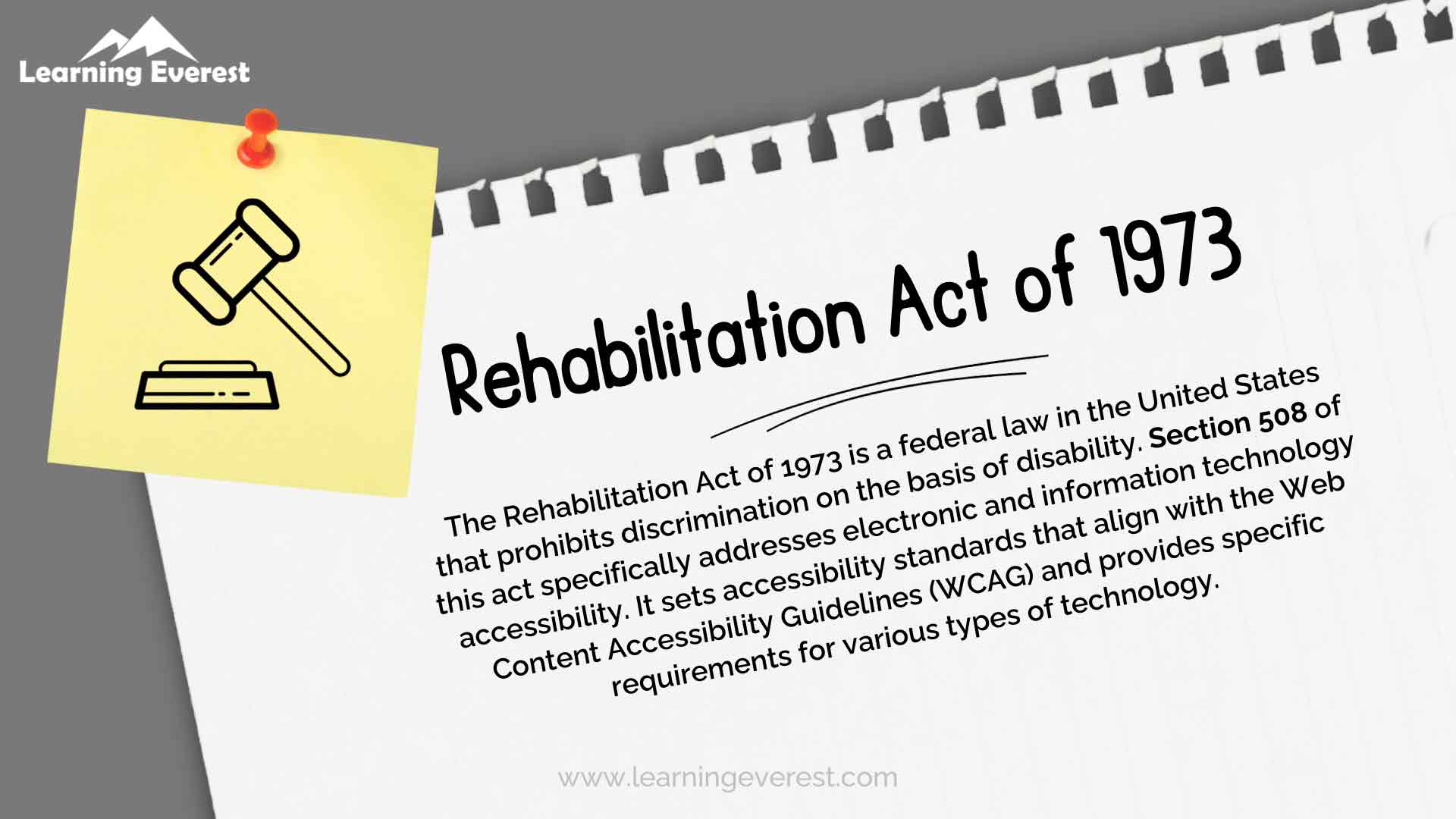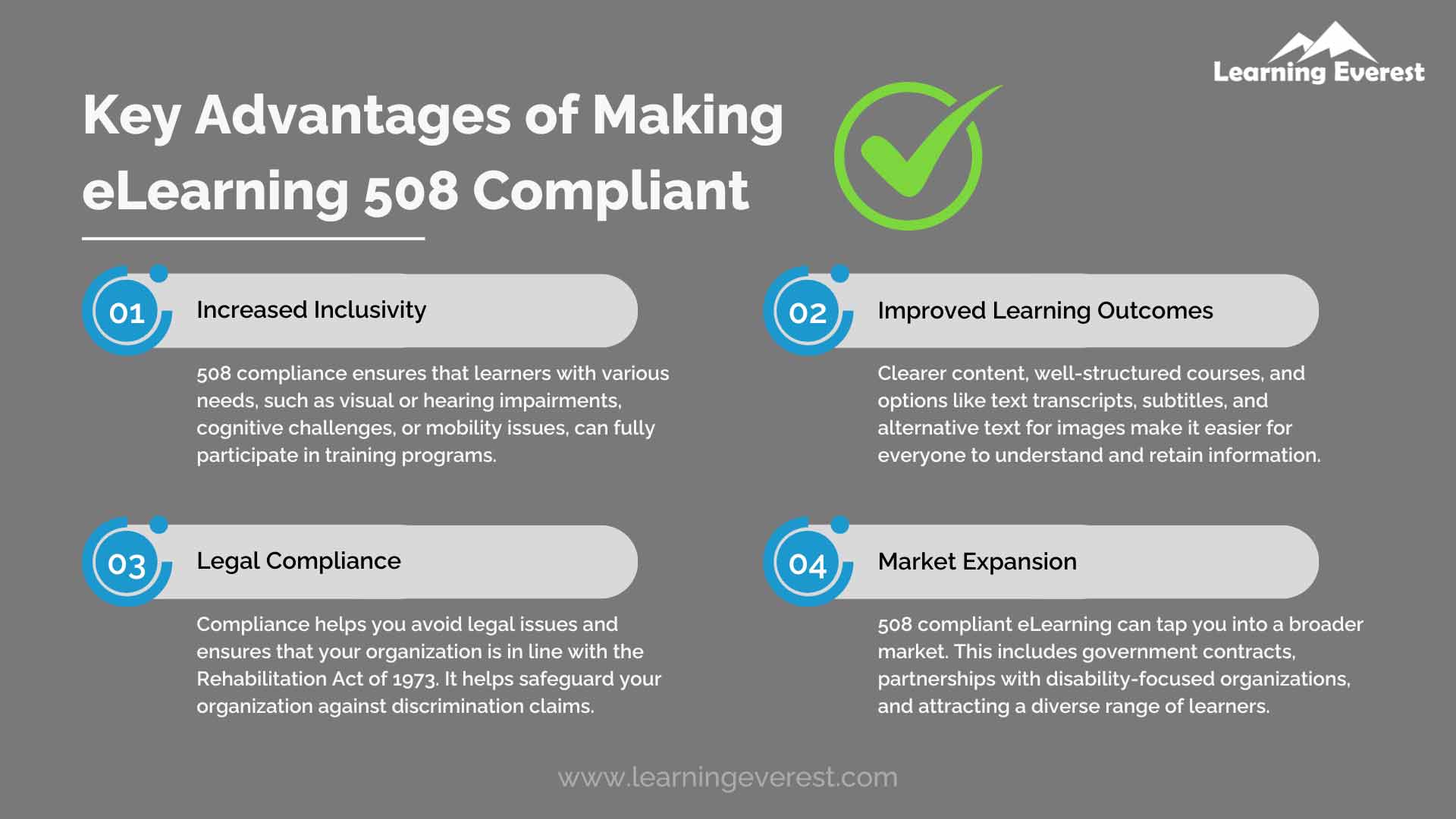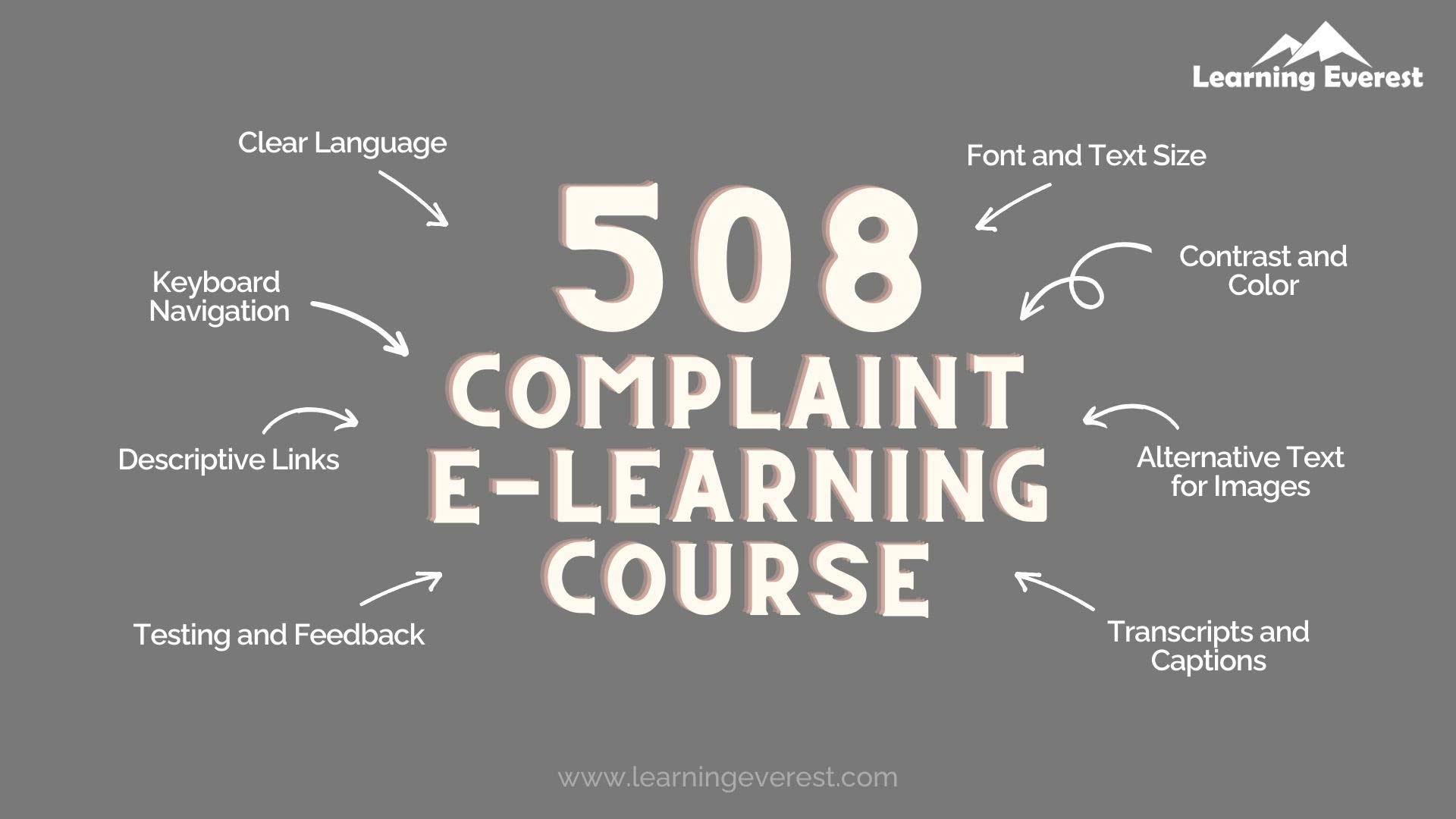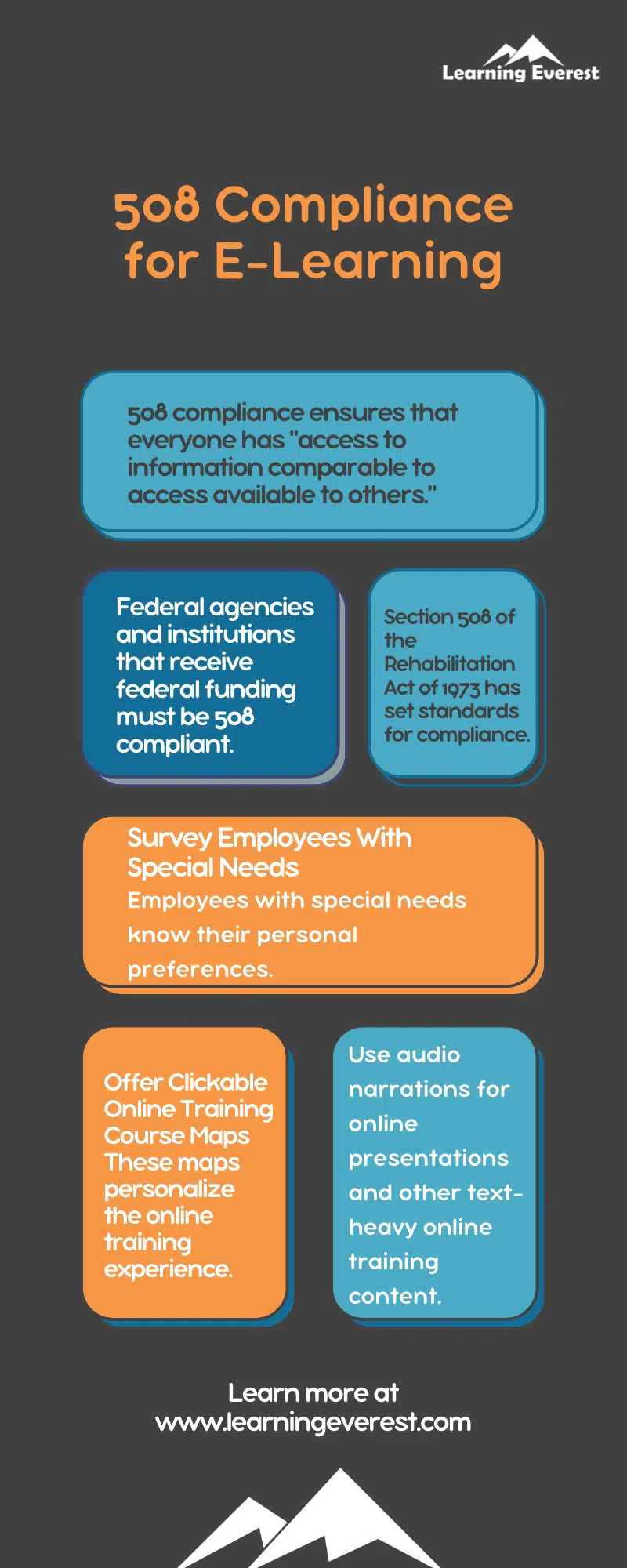Every employee in your organization is important, and therefore, everyone must be given proper training. In a business organization, learning content must be accessible for all. How do you address the needs of your employees with special needs? 508 compliance for eLearning addresses these needs. Please continue reading to learn more.
Table of Contents
- What Is 508 Compliance?
- Why Is 508 Compliance Important?
- How To Design Section 508
- Checklist to create a 508 compliant e-Learning course
- Infographics
- Frequently Asked Questions (FAQs)
- How do you make eLearning 508 compliant?
- What is eLearning accessibility?
- Is Articulate Storyline 508 compliant?
- Why is accessibility important in eLearning?
What Is 508 Compliance?
508 compliance ensures that everyone has “access to information comparable to access available to others.” Section 508 of the Rehabilitation Act of 1973 has set standards for compliance. Accordingly, federal agencies should provide software and website accessibility to people with disabilities.

508 Compliance for E-Learning – Rehabilitation Act of 1973
An eLearning course is 508 compliant if employees with disabilities can access all the training materials. Therefore, we need software optimized to meet 508 requirements. Storyline 3/360 is the software compatible with assistive technology.
Why Is 508 Compliance Important?
Federal agencies and institutions that receive federal funding must be 508 compliant.
These agencies and institutions include the following:
- government agencies
- public higher education institutions
- public K-12 schools
- federal-funded nonprofits
They have to use software and web tools accessible to people who have disabilities. Remember, people with disabilities might use supporting tools like screen readers. Moreover, many large private companies are also 508 compliant.

508 Compliance for E-Learning – Key Advantages of Making eLearning 508 Compliant
How To Design Section 508
Here are a few tips for creating Section 508 compliant learning courses for your employees:
Survey Employees With Special Needs
Employees with special needs know their personal preferences. Survey them beforehand to create effective learning content. Ask them their opinions about the current online training strategy. They might have difficulty accessing the interactive online training materials or would like to see more variety in the online training resources.
Incorporate Subtitles
Subtitles are for hard-of-hearing employees and second language speakers. Thus, they have the opportunity to turn on the subtitles and follow along or switch to their localized language. You can also focus on the key takeaways instead of including verbatim text.
Add Audio Narrations
Use audio narrations for online presentations and other text-heavy online training content. Visually impaired employees can listen to the vital takeaways. Ensure that you give employees the option to turn off the audio when necessary. Corporate learners should have complete control over the playback and volume levels.
Offer Clickable Online Training Course Maps
These maps personalize the online training experience. Thus, the learners with certain types of special needs can pick and choose assessments, modules, and activities that are the best for them. Instead of keeping up with co-workers, they can also go at their own pace.
Ensuring that your courses are 508 Compliant
Please, review the following areas of your course design before creating course content:
- Keyboards are the only means of navigation for learners with specific disabilities. The “Tab” key is often the primary navigation command. Explore the use of alternate short keys like the “Space bar.”
- At times the course designers do not use videos because of the 508 compliance issues. But what can be done? Add text prompts, descriptions, subtext, and closed captioning. These features make the video content accessible to learners with disabilities.
- Content for people with visual impairments should provide voice-over features. The voice-over must be clear and describe the information on the screen. Additionally, you can allow the learner to control the speed of the narration.
- Ensure that there are detailed narrations for images used in the course. Think about a learner who is visually impaired. The learner might not be able to respond well when there are instructions to look at a given figure. What can be done in such cases to make the content 508 compliant? Make detailed descriptions of the graphic in detail. This method is also known as adding alternate text to images.
- Provide text resizing configuration options within the course. Using sans serif fonts is recommended.
- Be careful about choosing colors. Though color blind learners can see clearly, it is challenging to distinguish text and images with red, green, or blue. Try to avoid these colors when you are designing the course.
- When producing materials in linked sections of the course, try to use other approaches. For instance, a visually impaired learner will not benefit from instructions such as “Click here to learn more…”. They won’t know where to click.
- Drop-Down Menus enhance the overall design of the course. However, they are not Section 508 compliant. Avoid them while developing a course.
- Multi-Modal Presentations are beneficial to learners with cognitive disorders. They may not respond well to purely single-modal lessons. Mix video, audio, graphics, animated, and textual content.
- Learners with Auditory Perceptual Deficit may have challenges with distinguishing similar-sounding tones. Moreover, they might not be able to hear the sound over other background noises accurately.
- When designing interactivity, 508 compliant eLearning courses becomes challenging. Linear courses that lack interactivity are indeed dull. However, ensure that the eLearning course is more straightforward if 508 compliance is the most critical priority for your client.
- Restrict the use of tables. But when you have to use them, break them up into smaller segments. Learners must be able to use the standard page or choose text-only presentations. The entire course can be made available in a transcript.

508 Complaint e-learning course
Checklist to create a 508 compliant e-Learning course
- All visual elements must be accessible.
- Provide alternative text for images.
- Consider font sizing and color contrast.
- Keep in mind the color contrast.
- Strong color contrasts are easier for colorblind learners to view your content.
- All audio must be parts accessible.
- Provide a text transcript for audio files.
- Include captioning for videos with audio.
- Closed captioning allows learners to read the audio portion of your video if they can’t hear it.
- The course must allow for keyboard input.
- Allow all functionality via a keyboard.
- Providing the option for complete keyboard control in your e-Learning course gives learners who cannot use a mouse the opportunity to use assistive technologies that mimic the keyboard, such as speech input.
- The authoring tool support accessibility.
- Choose an authoring tool that supports accessibility.
- Thus, it will be easier for you to make your course accessible to all your learners as a developer.
- Consider the feedback received.
- Incorporate user testing into your development process.
- Getting frequent feedback as you’re creating your e-Learning course will allow you to fix any areas that aren’t accessible—before it’s too late.
Creating 508 compliant training courses can be a challenge to instructional designers. But it’s definitely worth the time spent because it makes learning easier for your employees with special needs. Keep in mind how you can ensure the eLearning content in your organization is 508 compliant!
Infographics
Frequently Asked Questions (FAQs)
How do you make eLearning 508 compliant?
Simplifying the course structure, enabling navigation through a keyboard, close caption, color considerations, and text transcripts are some practical ways to make your eLearning course 508 compliant.
What is eLearning accessibility?
When everyone can experience the learning experience fully, a learning course is accessible. A partially sighted learner, for instance, should get the complete experience as a fully sighted person.
Is Articulate Storyline 508 compliant?
Yes. Storyline 360 and Studio 360 allow you to create courses that support Section 508 accessibility guidelines.
Why is accessibility important in eLearning?
It helps you meet the needs of all your learners with one training. Thus you don’t have to manage multiple versions of the same course.






